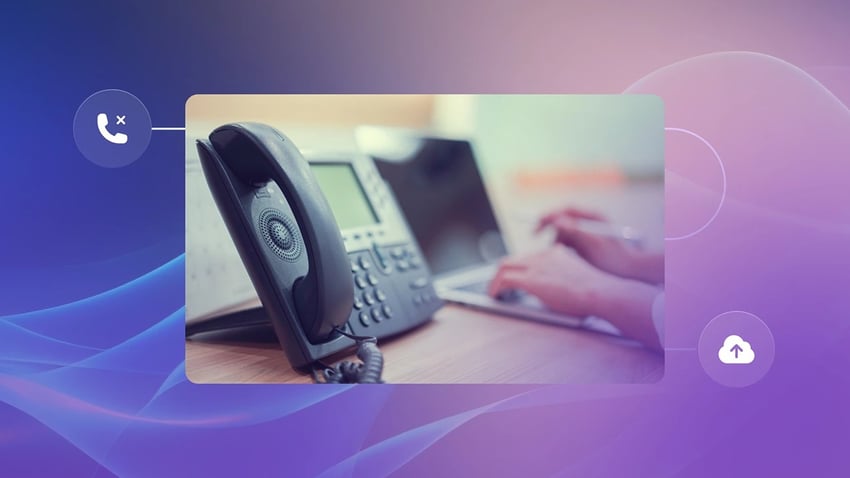Struggling to keep up with the competition? Are rivals growing faster, even without massive funding or huge account wins?
The answer might be simpler than you think. They’ve likely mastered asynchronous communication, a powerful business communication style that helps companies cut wasted time and get more work done faster.
Ineffective communication can cripple any company. Too little, and projects stall and derail. Too much, and your team is constantly distracted, unable to make real progress. The key is finding the right balance.
Asynchronous communication — working without the expectation of immediate responses — unlocks a whole new level of performance. This article will explore the benefits, limitations, and best practices of asynchronous communication to improve teamwork, especially for remote teams.
What Is Asynchronous Communication?
Asynchronous communication is exchanging information without requiring all participants to be present or respond simultaneously. Instead of real-time interactions like phone calls or video conferences, asynchronous communication relies on a time delay between sending and receiving messages. This allows individuals to contribute and respond within reasonable timeframes, at their own pace, and during peak productivity periods.
Think of it as sending an email or posting an update in a project management tool, rather than demanding an immediate meeting. This approach is particularly beneficial for:
- Geographically distributed teams: Bridging time zone differences between remote workforce.
- Complex projects: Allowing for thoughtful consideration and detailed responses.
- Focused work: Minimizing interruptions and promoting deep work.
- Inclusivity: Enabling participation regardless of individual schedules and working styles.
Asynchronous communication tools like email, project management platforms, and shared documents help teams share updates, provide feedback, and collaborate effectively without the constraints of immediate responses.
While async communication boosts productivity and morale, transitioning to it requires a deliberate cultural shift and awareness of its limitations, such as delayed responses or potential misunderstandings.
What Are Some Examples of Asynchronous Communication?
Asynchronous tools like email, instant messaging (for non-urgent communication), and team collaboration software facilitate communication at flexible times, so you can respond at your convenience rather than being interrupted by real-time demands. Below are a few common asynchronous communication examples:
Email and messaging platforms
Email remains a cornerstone for formal team communication and detailed information sharing. While messaging apps and platforms like Slack and Microsoft Teams enable real-time chat, they excel at asynchronous communication through threaded conversations. Integrated tools like Nextiva also offer team chat functionality that a team can use to discuss a specific project aspect, and members can contribute when they’re available.
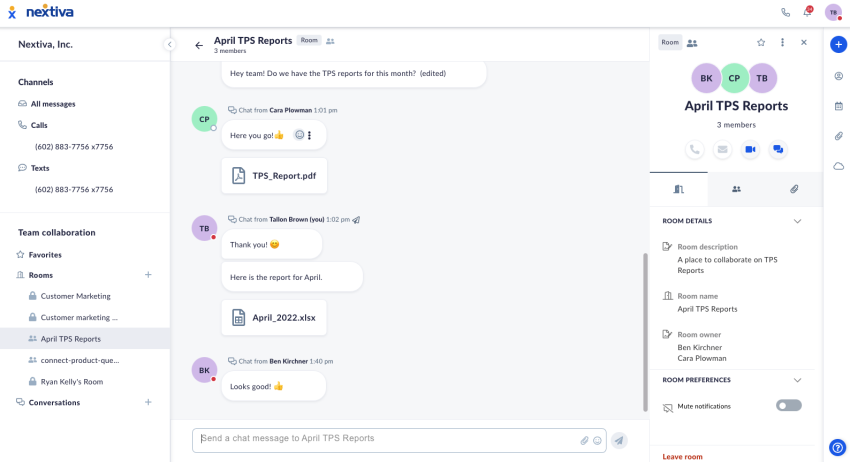
Document collaboration systems
Asynchronous communication tools like Google Docs and Microsoft Office Online allow multiple users to collaborate independently on documents, spreadsheets, and presentations. Integrated version control and commenting features track changes and enable asynchronous feedback. Several team members can work on different sections of a report in Google Docs simultaneously, leaving comments and suggestions for each other to address later, improving asynchronous collaboration.
Recorded videos and screen captures
Instead of live demonstrations, videos and screenshots (using async tools like Loom) can be shared to explain processes, provide training, or deliver presentations. Viewers can watch in their own time and revisit the content as needed. A team lead can record a Loom video explaining a new software feature, and team members can watch it when they have a free moment.

Knowledge bases and wikis
Corporate wikis and knowledge bases are central repositories for information, policies, procedures, and FAQs. Employees can access the information they need at any time, promoting self-service and reducing the number of recurring questions. For instance, a new employee can consult the company wiki to find answers to common questions about HR policies, rather than needing to schedule a meeting with HR.
Project management tools
Platforms like Asana, Trello, Jira, and Monday.com use task boards, comment sections, and notifications to keep teams aligned. Team members can update progress, ask questions, and provide feedback asynchronously. For instance, a team member can update the status of a task in Asana and tag a colleague for review, knowing the colleague will address it when their schedule allows.
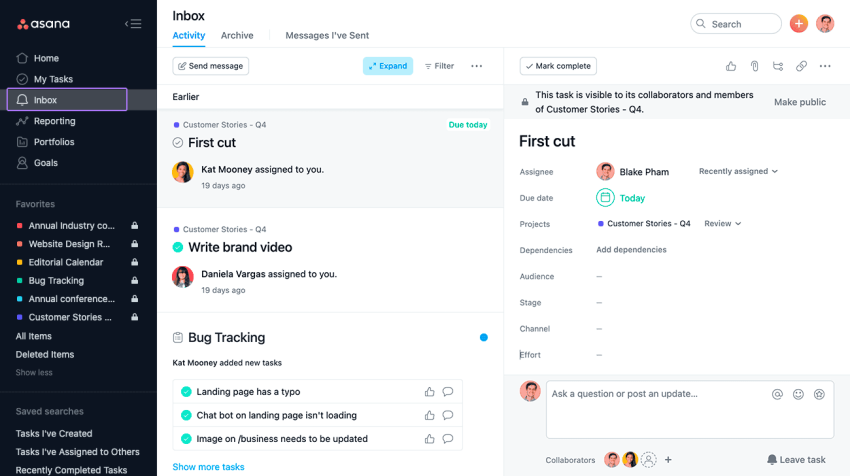
Asynchronous video updates
Short video updates, created with tools like Loom or Vidyard, can replace some live meetings. Participants can record updates on their progress, share insights, or ask questions, allowing others to access and respond at a convenient time. A project manager could provide a weekly project update via a short video, which team members can watch at their convenience.
These examples show that asynchronous communication isn’t just about the tools; it’s a mindset shift that prioritizes respecting employees’ time and enabling flexible, focused workflows.

Case Study: GitLab’s Async Success
GitLab sets the benchmark for asynchronous communication at scale. With over 1,500 employees spanning over 65 countries, GitLab has cultivated a thriving remote-first culture by embedding asynchronous work as its standard operating system.
Central to GitLab’s approach is its “manual-first” philosophy: prioritizing documentation of processes and decisions over lengthy meetings. The results speak for themselves:
- High reduction in meetings
- Increase in shared knowledge
- Higher employee satisfaction with work-life balance
- Faster onboarding for new team members
GitLab CEO Sid Sijbrandij explains their approach:
There is a reason we’re really good at async, and that is because we make things smaller. Through iteration, you don’t have to coordinate with a ton of people. By taking smaller steps through iteration, we can ship faster. The only way this is possible is through asynchronous communication.
The company makes decisions based on documented issues and merge requests, rather than in closed meetings. Instead of mandatory staff meetings, GitLab delivers company updates as recorded videos, which allows more flexible contributions.
Asynchronous vs. Synchronous Communication
Communication methods exist on a spectrum between fully synchronous and fully asynchronous.
Synchronous communication happens in real time, with participants engaging simultaneously via in-person conversations, conference calls, or live chat.
Asynchronous communication involves delayed responses, letting participants engage at different times through email, messaging, or document comments. This format is better suited for tasks requiring focused work, as it enhances productivity by allowing individuals to respond at their convenience, minimizing interruptions.
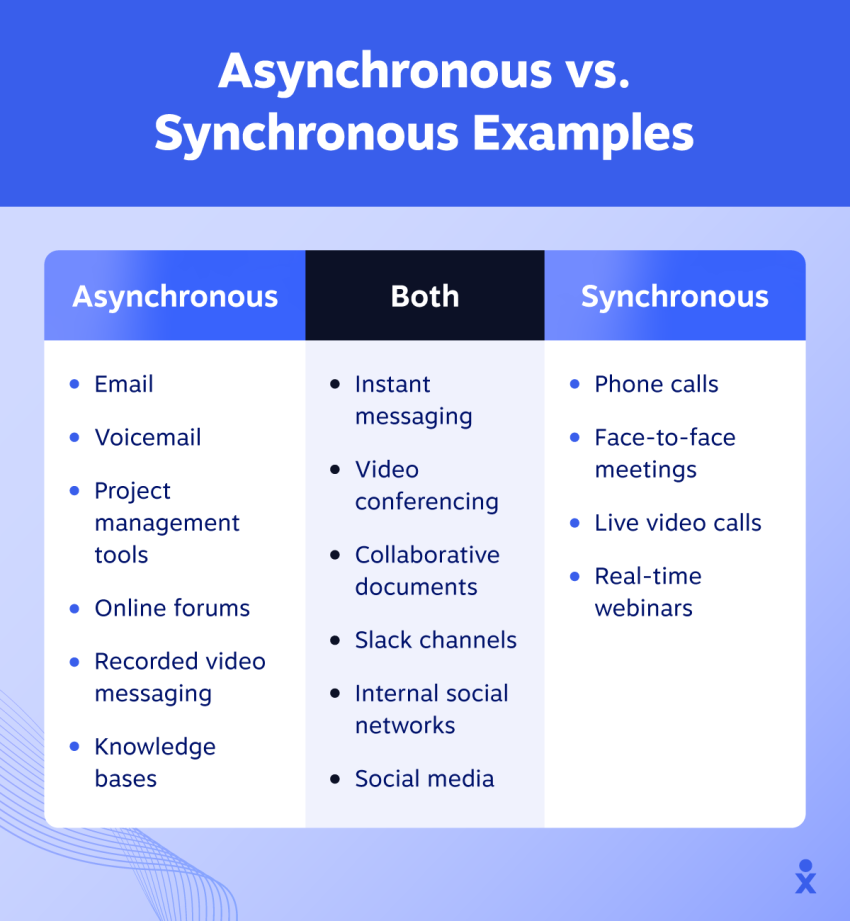
The boundaries between these approaches have blurred with modern tools. Chat platforms like Slack can function either synchronously or asynchronously depending on team expectations.
Most large and modern workplaces now combine synchronous and asynchronous communication methods to balance the need for immediate responses with the benefits of flexible, independent work. For example, a team might use synchronous communication for brainstorming sessions and urgent decisions, while relying on asynchronous communication for status updates and detailed feedback.
When to use each approach:
Use synchronous communication for situations that require immediate interaction and benefit from real-time discussion:
- Complex problem-solving requiring rapid back-and-forth
- Sensitive conversations where tone and emotion matter
- Team building and relationship development
- Crisis management and urgent decisions
- Brainstorming sessions benefiting from immediate ideas
- Situations requiring an immediate response
Use asynchronous communication for tasks that benefit from individual focus and flexible timing:
- Status updates and progress reports
- Detailed explanations and instructions
- Feedback requiring thoughtful consideration
- Information sharing across time zones
- Decision-making that benefits from reflection time
The most effective teams don’t rely on one approach; instead, they develop situational awareness to choose the method that best serves each specific need.
| Feature | Asynchronous Communication | Synchronous Communication |
|---|---|---|
| Timing | Not simultaneous | Real-time, simultaneous |
| Examples | Email, forums, recorded videos | Phone calls, video meetings |
| Response Time | Delayed, flexible | Immediate, instant feedback |
| Use Case | Distributed teams, deep work | Urgent issues, brainstorming |
Benefits of Asynchronous Communication
Improved productivity and focus
The constant interruptions of synchronous communication place a heavy burden on knowledge work. Studies show that it takes an average of 23 minutes to regain full concentration after an interruption. Asynchronous communication directly addresses this problem by creating space for focused work.
Software developers report 28% higher productivity during uninterrupted work blocks, while writers produce nearly 50% more content when they work in a focused manner instead of constantly checking messages.
Bundling messages and responding at set times protects employees’ valuable cognitive resources, which is their sustained attention. Asynchronous communication minimizes interruption and allows for deeper focus, leading to higher-quality work.

Enhanced decision quality
Instead of snap judgments made during real-time meetings, employees have the time to provide more thoughtful and informed input. They can research relevant data, consider different perspectives, and formulate well-reasoned responses, leading to more robust and effective decisions.
The format also naturally allows for a wider range of perspectives, as everyone can contribute, regardless of schedule, freedom of expression in meetings, communication style, or comfort level with speaking up in group settings. A broader range of perspectives contributes to a more comprehensive decision-making process and reduces the likelihood of decisions being overturned later.
Better work-life balance
Asynchronous communication enables team members to work on their own schedules, reducing distractions and supporting practices like time blocking. This flexibility reduces stress and improves work-life balance, as team members aren’t constantly interrupted by instant messages or numerous video calls, reducing meeting fatigue and Zoom burnout. Team members can focus on deep work without the pressure of immediate responses, leading to a greater sense of autonomy and ownership and boosting both morale and motivation.
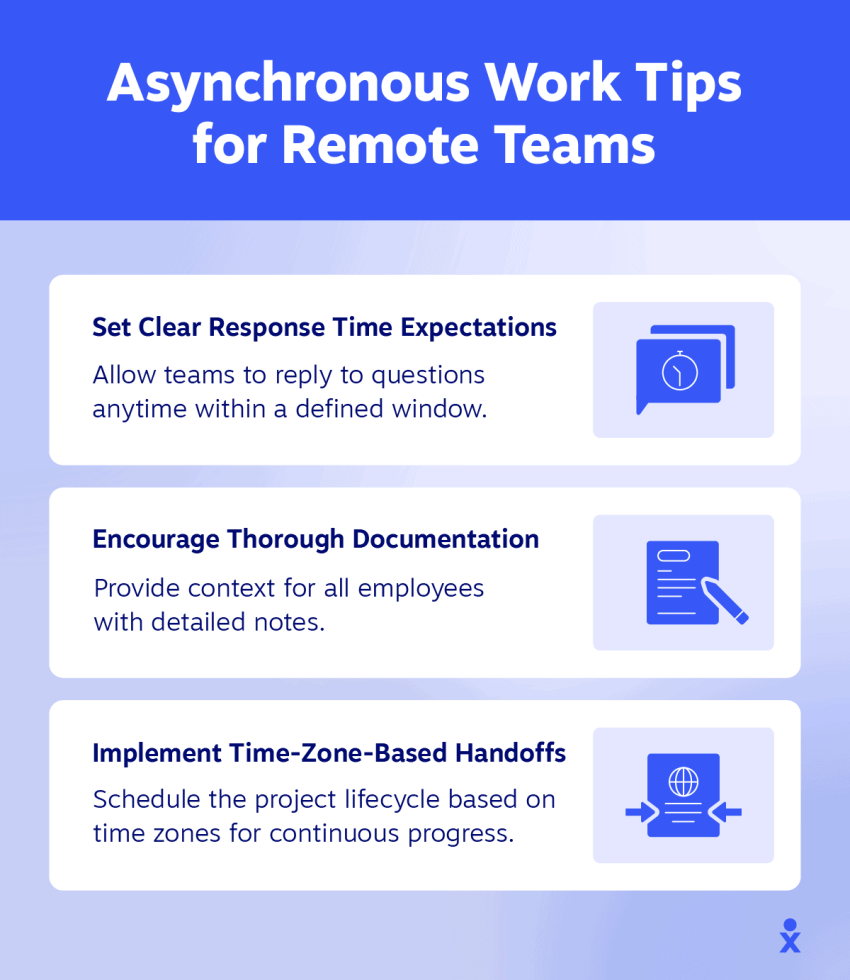
Other key benefits
- Improved documentation and communication: Conversations and decisions are automatically archived, preventing information overload and maintaining focus.
- Inclusivity: Team members in different time zones, or with different work styles, have an equal opportunity to contribute.
Challenges of Async Communication
Asynchronous communication also brings with it certain challenges that teams must actively address.
Delayed feedback loops
Without immediate responses, project timelines may lengthen if team members need input before proceeding with their work, and misunderstandings can persist longer before being clarified, causing bigger issues.
To mitigate this, establish clear expectations for response times based on urgency. Not every message requires the same timeline.
A thoughtful prioritization system (e.g., labeling messages as “Urgent,” “High Priority,” or “Low Priority”) helps team members understand when they need to respond immediately versus when they can take time for deeper consideration.
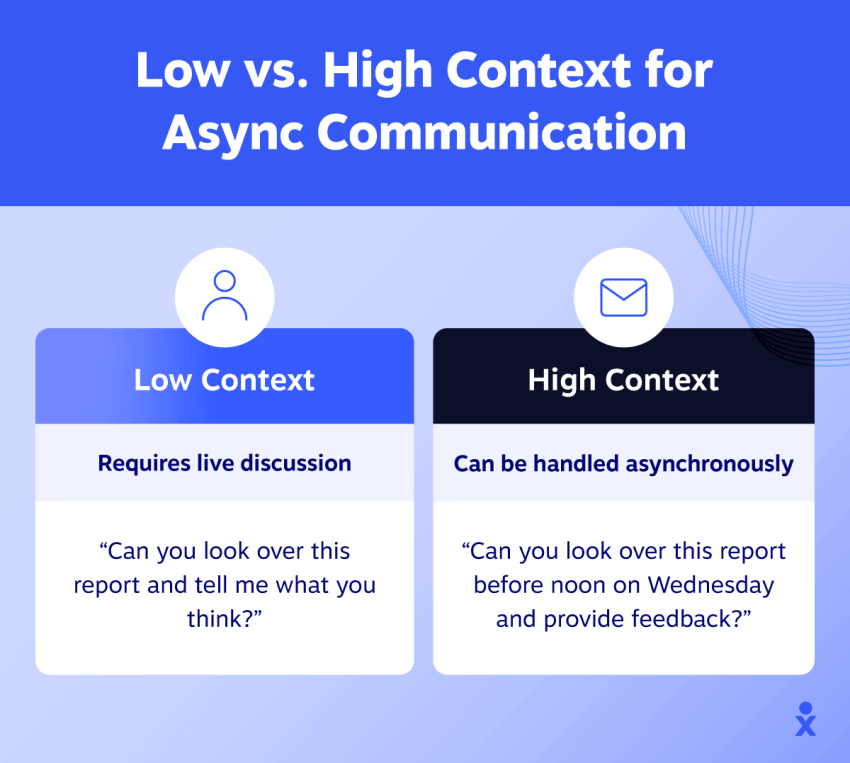
Communication clarity issues
Written communication lacks the nonverbal cues that convey meaning in face-to-face conversation. Written messages can be misinterpreted, causing unnecessary conflict when constructive feedback is perceived as criticism.
Complex topics may be more difficult to explain without interactive dialogue. Successful asynchronous teams mitigate these challenges by:
- Encouraging rich media (video, audio) for complex topics
- Developing team communication guidelines
- Normalizing clarifying questions before making assumptions
- Using emojis and other signals to convey tone
Social connection challenges
Remote workers who communicate primarily asynchronously may struggle with the reduced spontaneous interaction that traditionally builds relationships. The casual conversations before and after meetings are key to team cohesion.
To combat this isolation, intentionally create spaces for social interaction that don’t require real-time participation. Dedicated channels for non-work-related topics, asynchronous team-building activities, and regular synchronous social events also balance the efficiency of asynchronous work with the need for human connection.

Best Practices To Communicate Async
Effective asynchronous communication requires targeted practices that compensate for the lack of real-time interaction. These approaches help teams maximize benefits while minimizing challenges.
Provide comprehensive context
In synchronous communication, missing information gets clarified immediately through questions. Asynchronous communication lacks this immediate feedback loop, making context crucial for effective understanding. Include relevant background information and project history so recipients understand where your communication fits in the broader picture.
Explain the reasoning behind requests, not just what you need but why it matters. Link to relevant resources and previous discussions so people can dive deeper if needed.
For example, instead of simply asking “Can you update the website?” a contextual request would say:
| “Subject: Action Required: Update Pricing Page with New Enterprise Tier (Due Thursday). Can you update the pricing page on the website to reflect our new enterprise tier? This change was approved in last week’s product meeting (link to meeting notes). The updated pricing needs to be live before our email announcement goes out on Thursday morning. Please let me know if you anticipate any issues meeting this deadline.” |
Structure messages for scalability
Asynchronous communication is processed differently than real-time conversation. Recipients often review messages in batches or between other tasks, making scanability essential for effective comprehension. Here are some ways to improve scanability:
- Use descriptive subject lines and headers
- Break long content into clear sections with meaningful headings
- Bold key points or action items to make them stand out
- Place the most important information at the beginning
- Use bullet points for multiple items or steps
Document decisions and action items
Without the shared experience of synchronous meetings, asynchronous teams must carefully document results and responsibilities. This documentation ensures that everyone involved understands decisions and the next steps on the same page. Documentation should be stored in a central, easily accessible location, such as a project management tool, shared document, or company wiki.
A detailed decision summary might state:
| “Based on our discussion, we’ve decided to postpone the feature launch until Q2 due to the additional integration work required. Action items: Alex will update the roadmap by Friday, Jamie will communicate with customers by next Tuesday, and Chris will reallocate development resources starting with the next sprint.” |
Use rich media appropriately
Different communication needs call for different media types. Choosing the right format for your message improves clarity and reduces misunderstandings.
- Text is ideal for straightforward information and quick updates
- Videos work best for complex explanations or visual demonstrations
- Diagrams help clarify processes or relationships between ideas
- Voice messages convey tone and emotion when video isn’t necessary
For example, instead of writing a long email explaining a new UI flow, a product manager could create a three-minute screen recording walking through the design and add short text notes highlighting the key points.
Focus on iteration and progress, not perfection
Asynchronous work, when managed effectively, avoids the pitfalls of drawn-out processes and unnecessary delays. It empowers team members to work on multiple projects simultaneously, creating a team culture of autonomy and flexibility.
Reducing the need for constant meetings and synchronous communication enables teams to focus on making consistent, incremental progress rather than getting bogged down in achieving absolute perfection on the first try.
Implementing Asynchronous Communication
A successful transition to more asynchronous communication requires thoughtful implementation that considers both the technical and cultural aspects.
Start with a communication audit
Before making changes, understand your current state to identify the most impactful improvements. Individual team members, managers, or a dedicated team can all conduct a comprehensive communication audit.
It involves creating a diary for one week and logging all synchronous and asynchronous interactions with their purpose and outcome. This exercise shows patterns of unnecessary interruptions, redundant updates, and meetings that could be handled more efficiently through documentation.
Develop clear guidelines
Establishing expectations makes asynchronous communication successful by eliminating the ambiguity that creates anxiety in digital environments. A simple communication plan should answer:
- Which asynchronous communication tools to use for different types of communication
- Expected response times for different channels and urgency levels
- Boundaries around working hours and availability
- How to signal when something truly needs immediate attention
These guidelines create psychological safety by ensuring team members know when they can disconnect without letting others down while providing clarity about when rapid response is genuinely needed.
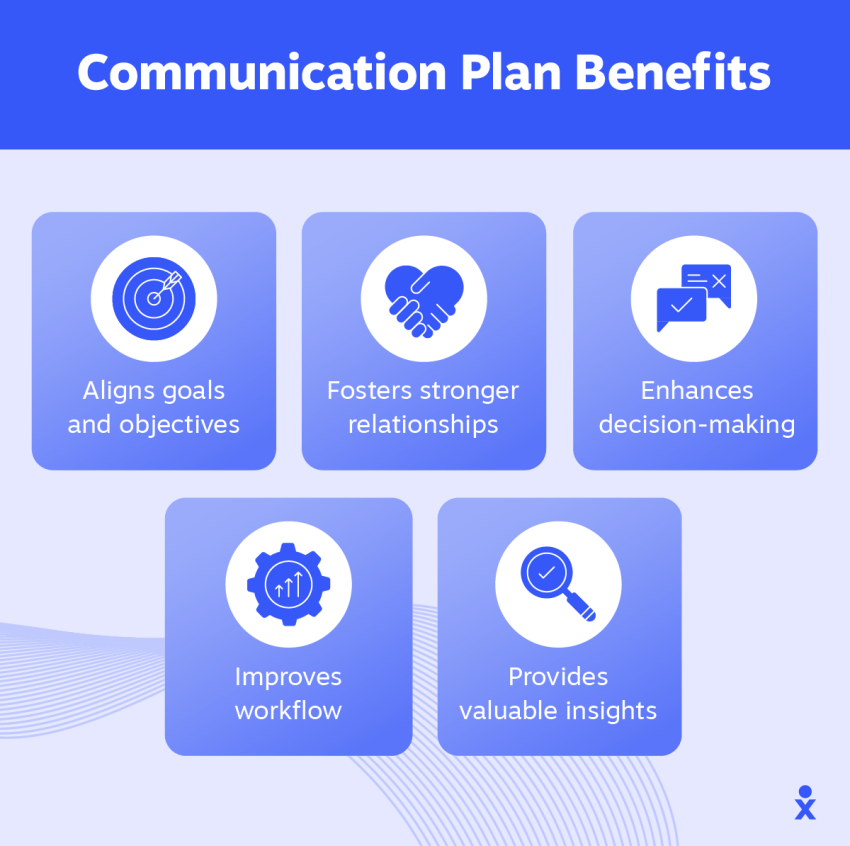
Address cultural barriers
Technical changes alone won’t create lasting transformation without addressing the cultural dimensions of communication. Many company cultures implicitly reward immediate responsiveness and meeting participation rather than the quality of thought or work output.
Having leadership model async communication practices sends a powerful signal that these approaches are valued. When executives document decisions rather than making them in closed rooms, write thoughtful updates instead of calling meetings, and respect focus time by not expecting immediate responses, it creates permission for others to follow suit.
Promote an asynchronous culture
Part of enabling effective async communication is cultivating an asynchronous mindset within the team. Encourage team members to decline meetings if they don’t think they need to be there and suggest that some meetings might be better served as async updates.
Publishing a meeting agenda or manifesto can help set clear expectations about when and how to schedule meetings, ensuring that only essential discussions take place synchronously. Support your teams in communicating asynchronously whenever possible and provide the necessary async tools and guidelines to guide this change.

Asynchronous Chat
Asynchronous chat blends the immediacy of messaging with the flexibility of asynchronous work. It helps teams reduce meeting overload while staying aligned and responsive, on their own time. Unlike live meetings or nonstop pings, async chat allows conversations to unfold gradually, giving everyone a chance to weigh in thoughtfully.
The value of async chat goes beyond convenience. It encourages intentional communication and helps preserve deep focus. But to be effective, async chat requires clear expectations and structure.
Here are four core principles for effective asynchronous chat:
- Set clear expectations: Define what types of messages are appropriate for async chat and how quickly team members should respond. Not everything needs to be instant, but it shouldn’t feel like a black hole either.
- Use threads to organize topics: Encourage your team to keep each topic in its thread. This reduces noise, improves visibility, and makes it easier to track discussions over time.
- Summarize for clarity: Long chat threads can get messy. Help everyone stay on the same page by recapping key decisions or open questions in a single message pinned or posted at the end of the conversation.
- Respect boundaries: Just because you’re working doesn’t mean others are. Avoid tagging or nudging people outside of core working hours unless it’s urgent, and make sure they know it’s OK to respond later.
Async chat is beneficial for cross-functional teams and distributed environments. It creates a shared space where everyone can contribute without being tethered to their devices or interrupted mid-task.
Asynchronous Communication Templates
To move beyond theory and start implementing asynchronous communication, you need practical tools. Here’s a customizable async communication plan template to help you optimize your processes.
👉 Download the communications plan templates: PDF and Google Sheets

Asynchronous Communication in Different Workplace Models
Asynchronous communication plays out differently across workplace models, each with unique opportunities and challenges. Here are a few common examples:
Remote-first businesses
In fully distributed enterprises, asynchronous communication is the primary operating system rather than just an occasional alternative. Remote businesses develop comprehensive documentation to replace the informal knowledge-sharing commonplace in physical workplaces.
Automattic, the parent company of WordPress.com, is a good example of this approach. With over 1,200 employees in 75 countries and no central office, the company has developed a sophisticated asynchronous infrastructure that replaces most meetings and makes information accessible across all time zones.
Flexibility in working hours and communication style is critical to increasing team productivity and improving work-life balance for remote workers, and asynchronous communication is a key enabler.
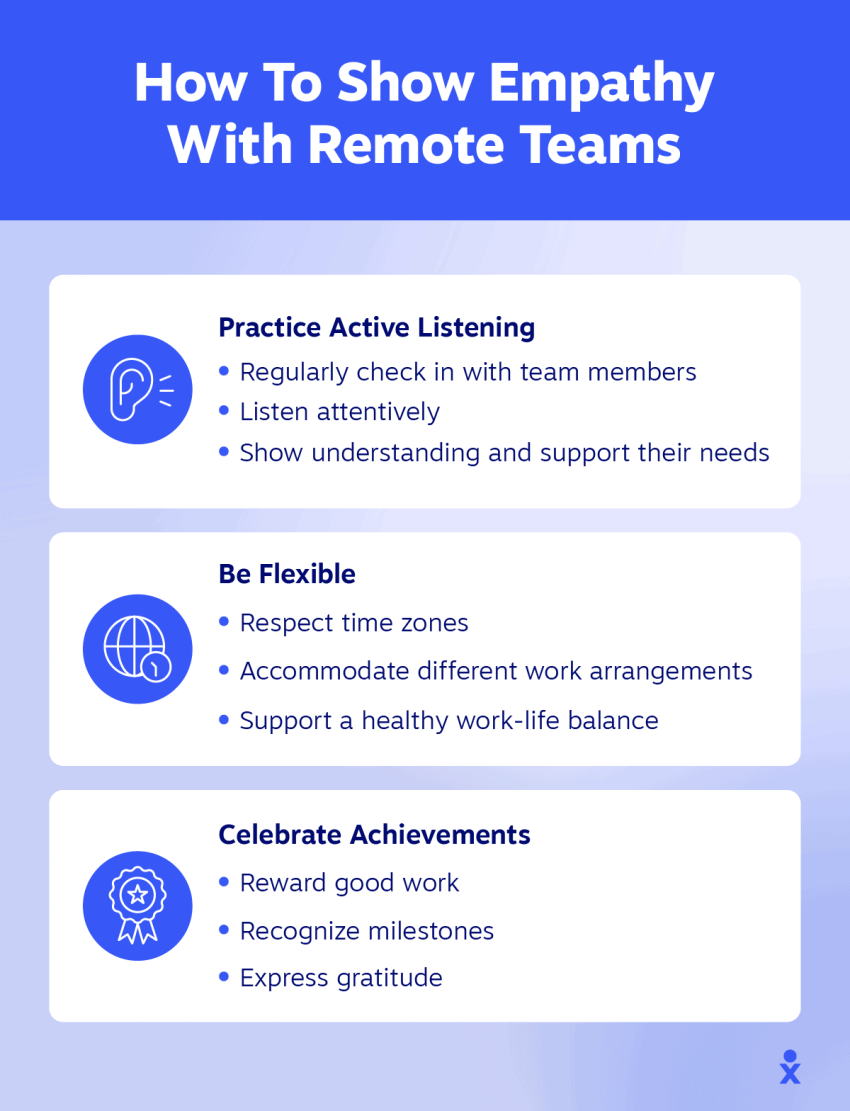
Hybrid workplaces
Companies with employees in the office and working from home face particular challenges in establishing equitable communication practices. Information asymmetries between in-office and remote employees can lead to a two-tier culture in which proximity to headquarters offers advantages. Hybrid workplaces should do the following to communicate async:
- Document all important discussions, even informal in-office and synchronous conversations
- Maintain “digital-first” communication even when co-located
- Design meeting formats that give equal voice to remote workers
- Create explicit norms about which communications happen in which channels
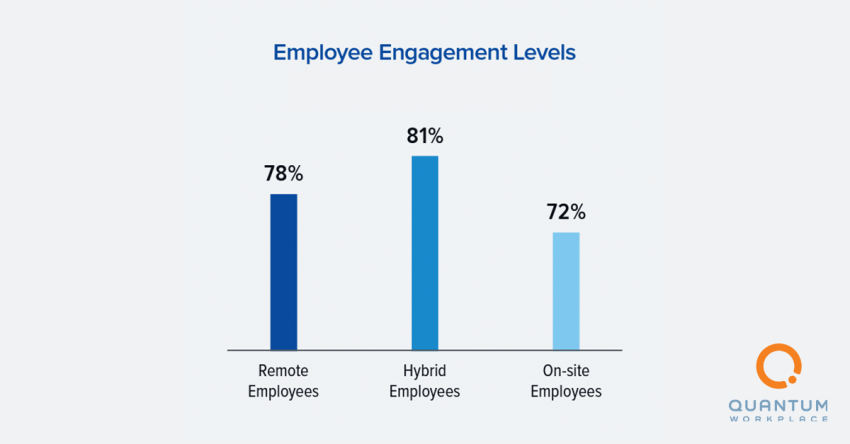
Traditional office settings
Even co-located teams benefit from asynchronous practices. Reduced meeting load creates more focus time, while documentation improves knowledge sharing and reduces interruptions. Written communication creates clearer accountability than verbal communication often forgotten after meetings.
An in-office marketing team might implement “no-meeting Wednesdays” with all communication happening through their project management system, resulting in higher creative output on those days.
Overcoming Common Obstacles To Async Communication
Implementing asynchronous communication encounters predictable obstacles. Proactively identifying and addressing them ensures successful implementation.
Resistance to change
When first introduced to asynchronous communication, many teams responded with: “That might work for software developers, but our work is different.” This objection appears across industries, from creative fields to customer service to executive leadership.
In reality, most knowledge work benefits from asynchronous approaches regardless of domain. The key to overcoming this resistance is starting with a small, low-risk implementation that demonstrates value. For example, a creative team might begin by having members share work updates asynchronously before their weekly review meeting, cutting the meeting time in half while improving preparation.
Documentation reluctance
Many professionals resist the additional documentation required for effective asynchronous communication. This reluctance often stems from seeing documentation as separate from “real work” rather than an integral part of the asynchronous workflow. To address this barrier:
- Create simple templates that reduce the friction of documentation
- Allocate explicit time for documentation rather than treating it as an afterthought
- Recognize and reward quality documentation contributions
- Demonstrate the value by tracking time saved through documentation
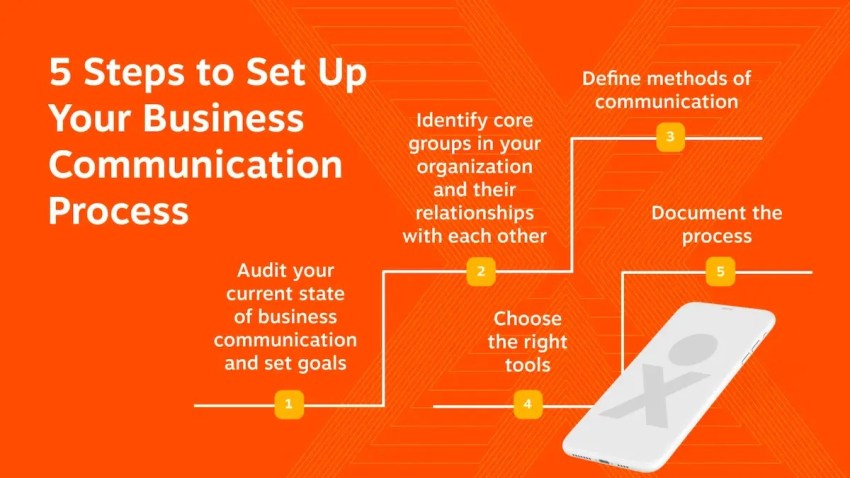
Anxiety about visibility and evaluation
Managers accustomed to evaluating work based on presence and observation may worry about how to assess performance in an asynchronous environment. Similarly, team members may worry that without constant visibility, managers will overlook their contributions.
Addressing these concerns requires shifting focus from activity to outcomes. This means establishing clear goals and deliverables that can be measured regardless of work style, creating regular asynchronous check-in processes (e.g., weekly written updates) that highlight accomplishments, and training managers on evaluating results rather than monitoring activity.
For example, a marketing team’s performance could be measured by website traffic, lead generation, and conversion rates, not by meeting attendance. A software development team could focus on code commits, completed features, and bug resolution time, rather than hours spent “online.” A customer service team could track customer satisfaction scores, resolution times, and the number of tickets resolved.
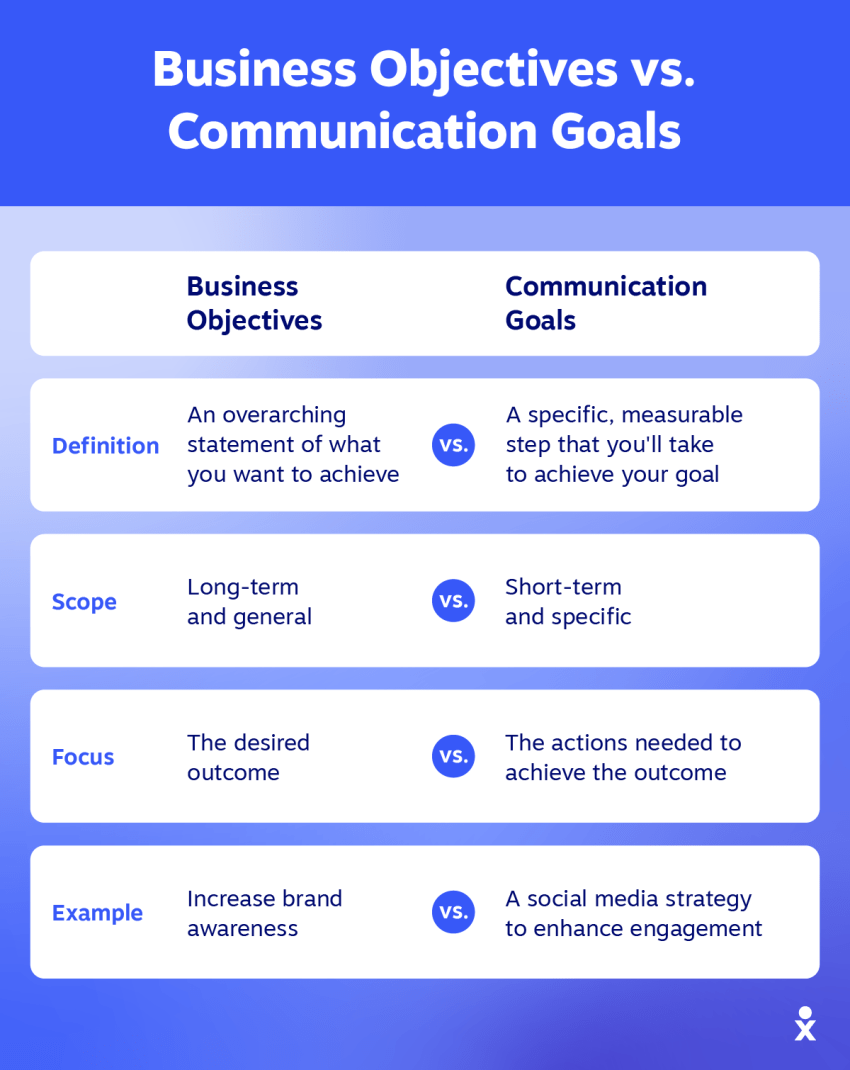
Async in Sync
Asynchronous communication isn’t just a set of tools or techniques; it’s a fundamental shift in how teams collaborate, make decisions, and share knowledge. When implemented thoughtfully, it creates a more inclusive, flexible, and productive work environment that benefits both employees and employers.
The most successful implementations balance the efficiency of asynchronous communication with the benefits of human connection that synchronous interaction provides. They recognize that the goal isn’t to eliminate real-time communication entirely but to be more intentional about when and how it’s used.
Start small, be patient with the learning curve, and focus on the long-term benefits. Asynchronous communication may require initial investment in new tools and practices, but the returns in productivity, employee satisfaction, and operational resilience are well worth the effort.
You hired your team to do their job, not to be full-time emailers, chatters, and meeting attendees. Always remember to invest in their well-being. Use asynchronous communication to give them the time and space to do their best work.
Resist the urge for a daily huddle. Instead, scribe your thoughts and data points in a shared document and ask for feedback. Your actions matter. If you message at all hours, expect instant responses, and don’t respect boundaries, neither will your team.
There are plenty of people out there who would love to tell you that asynchronous communication is the future of work. But, in reality, it’s just another style of work at your disposal. It’s up to you to decide when and how to use it best.
Enhance Office Communications With Nextiva
A feature-rich unified communications platform alleviates the uncertainty of synchronous communication. With the advice mentioned above, you can fully embrace an asynchronous communication culture. You hired your team to do their job, not to be full-time emailers, chatters, and meeting attendees. Use asynchronous communication to give them the time and space to do their best work.
All conversations in one place.
Say goodbye to messy apps, missed connections, and siloed conversations with Nextiva.
FAQs About Asynchronous Communication
Synchronous communication occurs in real-time, requiring immediate responses (such as meetings, synchronous calls, or live chat). Asynchronous communication allows for delayed responses, with participants engaging at different times, such as through email, recorded video, or document comments. The key difference is whether people need to be present simultaneously.
Key advantages include reduced interruptions for focused, deep work, greater flexibility for different schedules and time zones, automatic documentation of decisions, more thoughtful responses to complex questions, a better work-life balance, and more inclusive participation across various communication styles.
Potential challenges include slower feedback cycles for time-sensitive matters, the potential for misunderstandings without nonverbal cues, higher documentation overhead, reduced spontaneous or real-time collaboration, and learning curves for teams accustomed to synchronous work. Effective asynchronous communication relies heavily on clear and concise written communication, so teams may need to develop these skills.
Effective teams default to asynchronous for status updates, information sharing, and non-urgent matters while using synchronous communication for relationship building, complex problem-solving, and sensitive discussions. They create clear guidelines about which communication types belong in which channels and document synchronous discussions for those who couldn’t attend.
Start by clearly communicating the benefits of asynchronous communication, including increased focus, reduced interruptions, and a better work-life balance. Address concerns proactively, and involve the team in developing communication guidelines. Begin with a small-scale pilot project to demonstrate the value, and be prepared to iterate based on feedback. Highlight successful examples from other teams or companies.
Establish a clear protocol for urgent matters. This may involve using a specific communication channel (e.g., a dedicated Slack channel with notifications enabled), a designated “urgent” tag in project management tools, or even a phone call. Clearly define what constitutes an “urgent” matter to avoid overuse.
Asynchronous chat is a flexible way to communicate without demanding an immediate reply. Instead of pulling people into live meetings or constant back-and-forth, async chat gives team members the space to respond when they’re focused and ready.
Async chat is ideal for distributed teams, roles that require deep concentration, and companies seeking to minimize unnecessary interruptions. By removing the pressure to be “always on,” asynchronous chat helps preserve focus and encourages more deliberate communication.

















 Business Communication
Business Communication 











